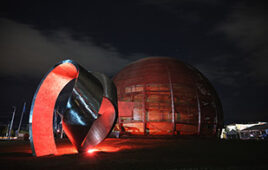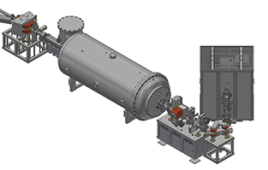 |
 |
 This Lynk Labs package (a) integrates two LED die with a coupling capacitor under a lens. The AC approach maximizes efficiency and minimizes complexities associated with DC current control. III-N Technology (b) and (c) uses strings of micro-LEDs within the footprint of a traditional LED to create a format that may be driven with AC line voltage. Because the DC convertors used with traditional LEDs add cost and reduce reliability, non-traditional LED designs may ease the path towidespread adoption of solid-state lighting. |
Unique approaches to solid-state lighting look to easethe transition from inefficient incandescent bulbsto highly efficient LED illumination.
Solid-state lighting can reduce overall energy usagein the U.S. by 10%, reduce global carbon emissionsby tens of millions of tons per year, and bring inexpensivelight to regions that have no infrastructure for healthyalternative lighting.
Players in the light-emitting diode (LED) industryhave publicized the advantages of LEDs, especiallytheir high electrical efficiency and long lifetime.Those advantages have driven LEDs to be the solutionof choice for certain applications, such as trafficsignals. But the big target for LED lighting remainsthe general lighting market: the residential and commercialillumination that uses between 10 and 40% of the electricalenergy at each site.
LED architecture
LEDs, like other solid-state diodes, are composed of a layer of hole-rich “p” material adjacent to a layer of electron-rich “n” material. When a forward bias voltage is placed across the diode, current flows. In LEDs, the electrons transported into the p material and/or the holes transported into the n material radiatively recombine.
The bandgap energy of the LED determines the wavelength of emission, giving rise to generally monochromatic illumination. White light, broadband emission can be generated from LEDs either by combining three individual monochromatic LEDs or by coating a blue or UV monochromatic LED with phosphorescent material. In the last 10 years new blue and UV LEDs have been offered in increasingly brighter illuminations that, in turn, makes brighter white light sources available.
More than just brightness
LED developers are continuing to push for improved brightness, with targets quoted in the range of 80 to 120 lm/W. Although the industry has not agreed on a standard method for measuring brightness, LEDs are already well above the 12-15 lm/W of incandescent bulbs, although they have a way to go before they can approach the 700 or so lumens per dollar of incandescent sources.
But the industry is becoming aware that it will take more than just achieving brightness and cost levels for LEDs to replace traditional light sources. Specifically, there is an infrastructure established for lighting, and LEDs must somehow fit into the existing infrastructure.
A primary aspect of the existing infrastructure is that electrical power is supplied to the point of use in alternating current format. For LEDs, this is an unfortunate fact, as individual LEDs work only when current is flowing in one direction, that is, in DC format. So, either LEDs bring with them a revamping of entire electrical distribution systems, or they somehow fit into the existing power grid.
Although it’s a bitter decision, LED lighting developers are adapting to the existing infrastructure. The decision is bitter because adding DC drivers adds to the cost and size of LED lighting, while at the same time reducing the lifetime and efficiency. So, although the advantages of LEDs would be multiplied if the existing power distribution was over a DC network, most developers have bowed to the inevitable, and include DC drivers in their systems. At the recent LEDs Conference in San Diego, Calif., sponsored by Intertech, two companies showcased a different approach.
Just plug it in!
Several years ago Hongxing Jiang and his colleagues at Kansas State Univ., Manhattan, developed a “µ-LED.” The µ-LED is about 8-µm dia., significantly smaller than the 300 µm length scale of traditional LEDs. To commercialize the technology, which uses gallium or other valence 3 elements in combination with nitride, Jiang formed III-N Technology, Inc., Manhattan, Kansas.
The µ-LEDs face the same fundamental issue as do traditional LEDs: they are DC devices. In addition, just like traditional LEDs, their lifetime will dramatically fall if they are overdriven—if too much current goes through the device. But because the devices are so small, an entire array composed of dozens of µ-LEDs can fit into the footprint of a traditional LED. By putting the LEDs in series a higher voltage can be applied to the string because the sum of the individual voltage drops of each µ-LED serves to limit the current. On the other hand, putting two µ-LEDs antiparallel to each other would allow them to operate on AC, as each diode draws current during a different phase of the power cycle.
III-N combined both approaches in the design of the µ-disk LED. The device, which fits within the 300-µm square footprint of a conventional LED, is composed of two antiparallel strings of µ-LEDs. The strings are composed of enough LEDs so the current is kept within bounds and one string operates on each phase of the power cycle. The result is an LED that can be directly plugged in to an AC power outlet.
Another approach to AC
III-N isn’t the only company offering an AC-driven solution. Lynk Labs of Elgin, Ill., also uses AC-coupled LEDs. Mike Miskin, president and CEO of Lynk Labs, has been working on unique AC power distribution systems for 15 years, including radiatively-coupled “no-return-path” (NRP) technology.
In the NRP system a single-wire antenna couples power to a resonant circuit. The current generated within the circuit depends on the relationship between the frequency of the supply and the resonant frequency of the load. Applying the same principle to LED drivers, Lynk developed capacitive current controlled LEDs.
Lynk’s system uses modified halogen power converters, with efficiency better than 90%, to provide 6-120 VAC modulated at 20-80 kHz. The supply is connected to an LED assembly through an AC-coupling capacitor. To maximize the efficiency, each capacitor is coupled to a pair or string of antiparallel LEDs, using both phases to generate light, as in the III-N design.
The current through the LEDs is determined by the relationship between the source voltage and frequency and the capacitor value at the LEDs. Because the current is controlled at each load, a single AC-driver can be used to power strings of different lengths composed of different types of LEDs. This is in marked contrast to conventional DC drivers, where the current is controlled at the source, meaning each driver must be tailored to the specific number of LED assemblies it is driving.
One implication is that Lynk’s AC-coupled LEDs can be added and removed at will, without changing the driver. “Conceivably, one driver could be used to power all the solid-state lighting within an entire home,” says Miskin.
Poised for change
Solid-state lighting is perhaps the epitome of a disruptive technology, because it implies not only the creation of a new infrastructure, but also a withering of the old. Kathryn Conway, an LED consultant and co-chair of the Intertech LED conference, notes that the nature of light delivery may change.
Similar to the way in which laptop computers and cell phones are replacing centralized systems, LED task lighting may also become personalized and portable. Developers such as CREE, Durham, N.C.; Nichia, Tokyo, Japan; OSRAM, Munchen, Germany; and Lumileds, San Jose, Calif., are all offering brighter and less expensive LEDs.
Although the form of general lighting of the future and the role of given technologies is unknown, it is certain that solid-state illumination will have a significant impact. As Conway summarizes, “The attitude among the participants is ‘nose to the grindstone’ because there is business; real business with real milestones.”
— Richard Gaughan
Founder and Chief Engineer Mountain Optical Systems Technology
www.mountainoptical.com




